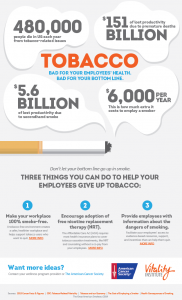This years World Cancer Day comes with a tagline Not beyond us, highlighting a proactive global approach to cancer prevention which includes promoting healthy lifestyles. Cancer is the second largest contributor to non-communicable disease (NCD) deaths worldwide, causing significant suffering and impacting employer healthcare and productivity costs. The workplace is well positioned to both improve workforce health and reap the economic benefits of doing so.
Cancer is a leading threat to global economic growth, costing the global economy over US $895 billion due to premature death and disability. It is the second and sixth leading cause of long-term and short-term disability claims, respectively, in the US.
Tobacco causes over five million deaths annually and over 200,000 employee deaths are caused by workplace-related cancers each year. Nearly 40% of cancers are linked to lifestyle risk factors including smoking, a poor diet, and physical inactivity.
Cancer prevention starts with tobacco control. Smoke-free workplaces and access to effective cessation programs and products are some elements that can be implemented by employers as their commitment to national laws and the Framework Convention on Tobacco Control (see this infographic for more information on actions employers can take). Businesses can follow the lead of companies like Johnson & Johnson, which implemented a broad program to develop a culture of health including prohibiting tobacco use at 98% of the companys locations. Employers should also aim to further reduce exposure to workplace carcinogens like asbestos, which kills over 90, 000 employees annually.
Beyond this, comprehensive evidence-based workplace health and well-being programs are available to stimulate healthy diets and activity with a focus on weight management. Employer use of financial incentives combined with cessation programs for smoking and wearable technologies for healthy eating/active living have been demonstrated to alter workforce lifestyle risk factors.
At least half of new cancer cases can be detected earlier through screening, and employers can help by promoting secondary prevention for common cancers like colorectal, breast and cervix, supporting evidence-based screening and enhanced access to vaccines, including HPV and HBV. Leading employers have initiated employee screening programs.
Businesses are well positioned to influence the health of employees, their families, and communities while simultaneously benefiting economically. We urge employers worldwide to join the fight against cancer today. One way to start is by participating in the Institutes free webinar series on evidence-based health promotion and chronic disease prevention. Our next webinar The Battle Against Tobacco is not Over but There are Innovative Solutions will feature David Abrams from Legacy and Mark Cunningham-Hill, who will share innovative strategies for workplace tobacco control and how they have been implemented at J&J.

Thumbnail source: World Cancer Day Thunderclap
In-blog image source: Workplace Safety North Cancer Prevention Guide







